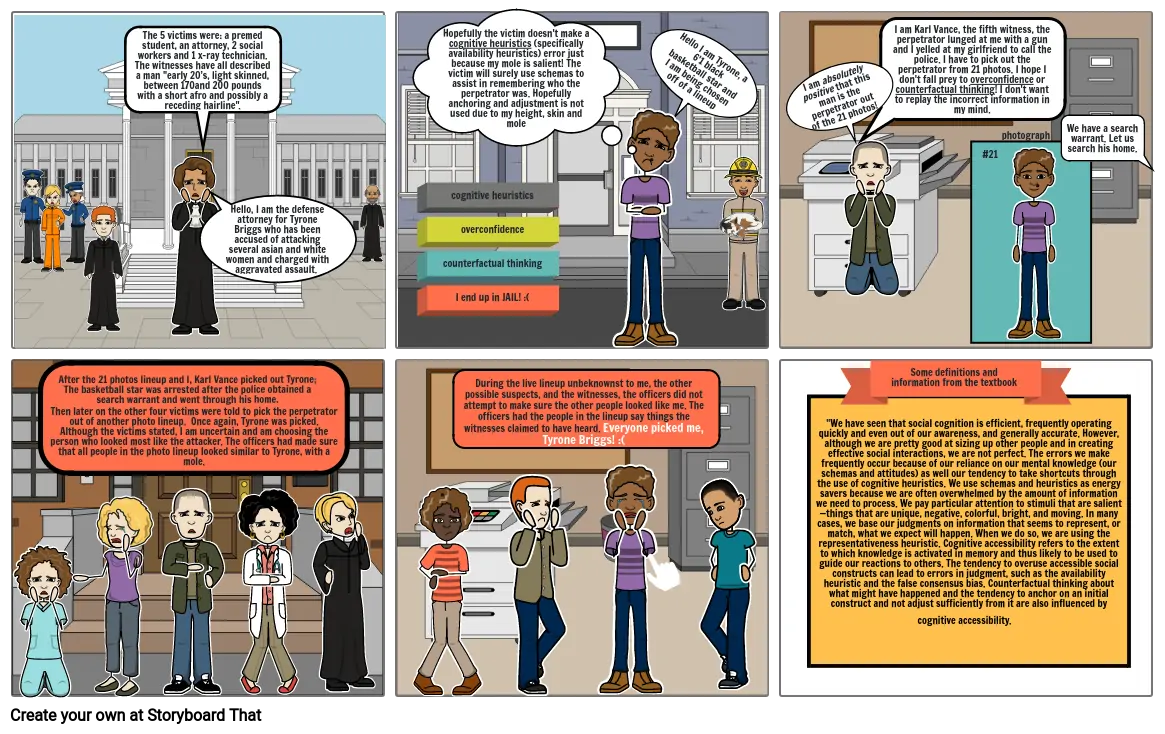"A Case of Mistaken Identity? The Psychology of Eyewitness Memory"

Storyboard Text
- The 5 victims were: a premed student, an attorney, 2 social workers and 1 x-ray technician. The witnesses have all described a man "early 20’s, light skinned, between 170and 200 pounds with a short afro and possibly a receding hairline".
- Should I hire an eyewitness memory expert to testify?
- Hello, I am the defense attorney for Tyrone Briggs who has been accused of attacking several asian and white women and charged with aggravated assault.
- I just read "a defense attorney newsletter that outlines some of the problems with eyewitness identifcation and have looked at the National Institute of Justice’s guidelines for law enforcement commissioned by the U.S. Attorney General." I believe the suspect is a victim of mistaken identification.
- Hopefully the victim doesn't make a cognitive heuristics (specifically availability heuristics) error just because my mole is salient! The victim will surely use schemas to assist in remembering who the perpetrator was. Hopefully anchoring and adjustment is not used due to my height, skin and mole
- cognitive heuristics overconfidence counterfactual thinking I end up in JAIL! :(
- Hello I am Tyrone, a 6'1 black basketball star and I am being chosen off of a lineup
- I am absolutely positive that this man is the perpetrator out of the 21 photos!
- I am Karl Vance, the fifth witness, the perpetrator lunged at me with a gun and I yelled at my girlfriend to call the police. I have to pick out the perpetrator from 21 photos. I hope I don't fall prey to overconfidence or counterfactual thinking! I don't want to replay the incorrect information in my mind.
- #21
- photograph
- We have a search warrant. Let us search his home.
- Then later on the other four victims were told to pick the perpetrator out of another photo lineup. A week later the 5th victim also picked Tyrone. Once again, Tyrone was picked. Although the victims stated, I am uncertain and am choosing the person who looked most like the attacker. The officers had made sure that all people in the photo lineup looked similar to Tyrone, with a mole.
- After the 21 photos lineup and I, Karl Vance picked out Tyrone; The basketball star was arrested after the police obtained a search warrant and went through his home.
- During the live lineup unbeknownst to me, the other possible suspects, and the witnesses, the officers did not attempt to make sure the other people looked like me. The officers had the people in the lineup say things the witnesses claimed to have heard. Everyone picked me, Tyrone Briggs! :(
- "We have seen that social cognition is efficient, frequently operating quickly and even out of our awareness, and generally accurate. However, although we are pretty good at sizing up other people and in creating effective social interactions, we are not perfect. The errors we make frequently occur because of our reliance on our mental knowledge (our schemas and attitudes) as well our tendency to take shortcuts through the use of cognitive heuristics. We use schemas and heuristics as energy savers because we are often overwhelmed by the amount of information we need to process. We pay particular attention to stimuli that are salient—things that are unique, negative, colorful, bright, and moving. In many cases, we base our judgments on information that seems to represent, or match, what we expect will happen. When we do so, we are using the representativeness heuristic. Cognitive accessibility refers to the extent to which knowledge is activated in memory and thus likely to be used to guide our reactions to others. The tendency to overuse accessible social constructs can lead to errors in judgment, such as the availability heuristic (things that come to our mind very easily, because we experience them more often so we think these things are happening more in general) and the false consensus bias ("We tend to see other people as similar to us."). Counterfactual thinking about what might have happened and the tendency to anchor on an initial construct and not adjust sufficiently from it are also influenced by cognitive accessibility."
- Some definitions and information from the textbook
Over 30 Million Storyboards Created

